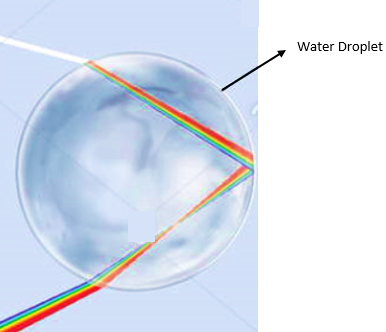
Rainbow is formed due to which of the following?
A.)By dispersion of sunlight through water droplets present in the atmosphere.
B.)By scattering of sunlight through water droplets present in the atmosphere.
C.)By reflection of sunlight through water droplets present in the atmosphere.
D.) None of these
Answer
534.6k+ views
Hint: Reflection is the bouncing of light when it falls on an obstacle. Refraction is the bending of light when it passes through one medium into another. Dispersion is the splitting of white light into its constituent colors.
Complete step-by-step answer:
We all know what a rainbow is and how beautiful it is, but have you ever wondered about how it is formed. What makes that rainbow appear as seven beautiful colours? It is due to the dispersion of the white when the light enters a water droplet in the atmosphere. Dispersion is the splitting of the white light into its constituent colours. Even in prism, we can this phenomenon.
Dispersion is due to the refraction of the white light, when it enters a different medium. Refraction is the bending of light when it passes from one medium to another medium. This bending of light depends on the wavelengths of the light in both the mediums. Since light is made of different colours of different wavelengths, the deviation of each colour is different and we can see the constituent colours of the light, after the refraction. Therefore, when light enters a water droplet, it is first dispersed due to refraction. Then the dispersed light comes out of the water droplet and enters our eye. Since, all the colours come at different angles; we can see the light as a rainbow of several colours. That is why on rainy days we see a rainbow only when there is bright sunlight.
When light enters from one medium to the other, some of it is reflected back and rest is refracted. Even when the refracted light falls on the other surface of the water droplet some it is internally reflected.

Hence, a rainbow is formed due to the refraction, dispersion and reflection of the sunlight that passes through the water droplets present in the atmosphere.
Hence, the correct option is D.
Note: When light passes from a denser medium to a rarer medium, there is no refraction and instead of that reflection takes place. This kind of reflection is called total internal reflection. Total internal reflection depends on the angle of incident. If the angle of incident is more than a certain angle called the critical angle, the light is reflected back into the same medium and not refracted out.
Complete step-by-step answer:
We all know what a rainbow is and how beautiful it is, but have you ever wondered about how it is formed. What makes that rainbow appear as seven beautiful colours? It is due to the dispersion of the white when the light enters a water droplet in the atmosphere. Dispersion is the splitting of the white light into its constituent colours. Even in prism, we can this phenomenon.
Dispersion is due to the refraction of the white light, when it enters a different medium. Refraction is the bending of light when it passes from one medium to another medium. This bending of light depends on the wavelengths of the light in both the mediums. Since light is made of different colours of different wavelengths, the deviation of each colour is different and we can see the constituent colours of the light, after the refraction. Therefore, when light enters a water droplet, it is first dispersed due to refraction. Then the dispersed light comes out of the water droplet and enters our eye. Since, all the colours come at different angles; we can see the light as a rainbow of several colours. That is why on rainy days we see a rainbow only when there is bright sunlight.
When light enters from one medium to the other, some of it is reflected back and rest is refracted. Even when the refracted light falls on the other surface of the water droplet some it is internally reflected.

Hence, a rainbow is formed due to the refraction, dispersion and reflection of the sunlight that passes through the water droplets present in the atmosphere.
Hence, the correct option is D.
Note: When light passes from a denser medium to a rarer medium, there is no refraction and instead of that reflection takes place. This kind of reflection is called total internal reflection. Total internal reflection depends on the angle of incident. If the angle of incident is more than a certain angle called the critical angle, the light is reflected back into the same medium and not refracted out.
Recently Updated Pages
Master Class 10 General Knowledge: Engaging Questions & Answers for Success

Master Class 10 Computer Science: Engaging Questions & Answers for Success

Master Class 10 English: Engaging Questions & Answers for Success

Master Class 10 Social Science: Engaging Questions & Answers for Success

Master Class 10 Maths: Engaging Questions & Answers for Success

Master Class 10 Science: Engaging Questions & Answers for Success

Trending doubts
The shortest day of the year in India

Why is there a time difference of about 5 hours between class 10 social science CBSE

Write a letter to the principal requesting him to grant class 10 english CBSE

What is the median of the first 10 natural numbers class 10 maths CBSE

The Equation xxx + 2 is Satisfied when x is Equal to Class 10 Maths

State and prove converse of BPT Basic Proportionality class 10 maths CBSE




